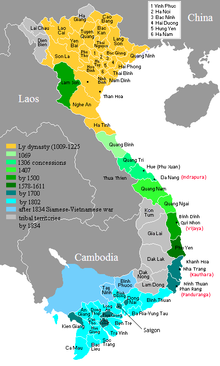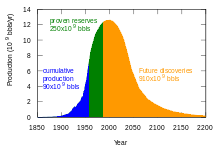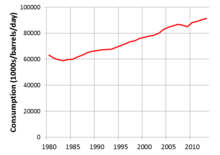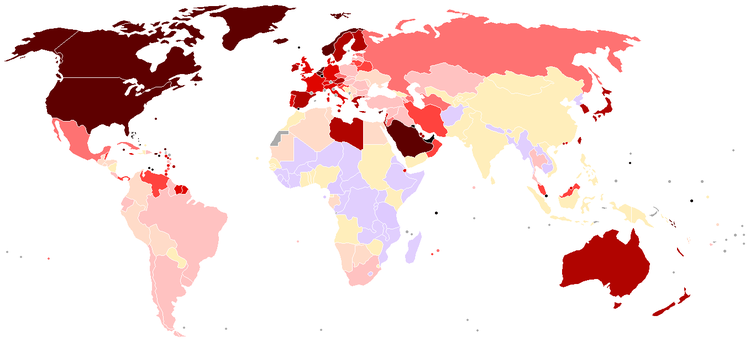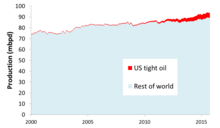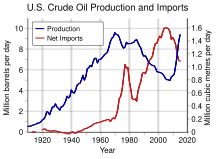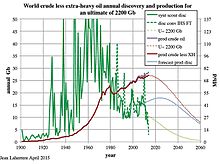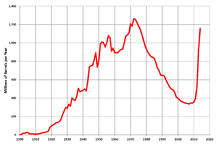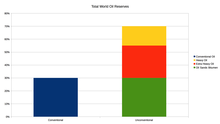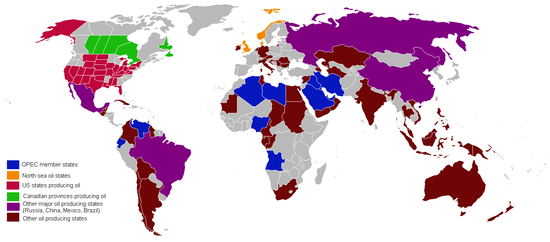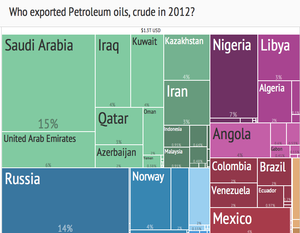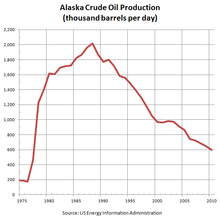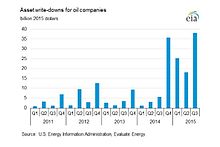Societal collapse (also known as civilizational collapse) is the fall of a complex human society characterized by the loss of cultural identity and of socioeconomic complexity, the downfall of government, and the rise of violence. Possible causes of a societal collapse include natural catastrophe, war, pestilence, famine, and depopulation. A collapsed society may revert to a more primitive state, be absorbed into a stronger society, or completely disappear.
Virtually all civilizations have suffered this fate regardless of size or complexity. But some revived and transformed, such as China and Egypt, while others never recovered, such as the Mayan Empire and the civilization on Easter Island. Societal collapse is generally a quick process, but rarely abrupt. Yet some have not collapsed but have only gradually faded away, as in the case of the British Empire since 1918.
Anthropologists, (quantitative) historians, and sociologists have proposed a variety of explanations for the collapse of civilizations involving causative factors such as environmental change, depletion of resources, unsustainable complexity, decay of social cohesion, rising inequality, secular decline of cognitive abilities, loss of creativity, and misfortune. However, complete extinction of a culture is rare; in most cases, the new societies that arise from the ashes of the old one are evidently its offspring, despite a dramatic reduction in sophistication. Moreover, the influence of a collapsed society, say that of the (Western) Roman Empire, may linger on long after its death.
The study of societal collapse, collapsology, is a topic for specialists of history, anthropology, sociology, and political science. More recently, they are joined by experts in cliodynamics and study of complex systems.
Concept
Joseph Tainter frames societal collapse in his The Collapse of Complex Societies (1988), which is a seminal and founding work of the academic discipline on societal collapse. He elaborates that 'collapse' is a "broad term," but in the sense of societal collapse he views it as "a political process." He further narrows societal collapse as a rapid process (within "few decades") of "substantial loss of sociopolitical structure," giving the fall of the Western Roman Empire as "the most widely known instance of collapse" in the Western world.
Others, particularly in response to the popular Collapse (2005) by Jared Diamond and more recently, have argued that societies discussed as cases of collapse are better understood through resilience and societal transformation, or "reorganization", especially if collapse is understood as a "complete end" of political systems, which according to Shmuel Eisenstadt has not taken place at any point. Eisenstadt also points out that a clear differentiation between total or partial decline and "possibilities of regeneration" is crucial for the preventive purpose of the study of societal collapse.
Societal longevity
Social scientist Luke Kemp analyzed dozens of civilizations—which he defined as "a society with agriculture, multiple cities, military dominance in its geographical region and a continuous political structure"—from 3000 B.C. to 600 A.D. and calculated that the average life span of a civilization is close to 340 years. Of these, the most durable were the Kushite Kingdom in Northeast Africa (1,150 years), the Aksumite Empire in Africa (1,100 years), and the Vedic Civilization in South Asia and the Olmecs in Mesoamerica (both 1,000 years), while the shortest-lived were the Yuen-Yuen Dynasty (30), the Nanda Empire in India (24), and the Qin Dynasty in China (14).
A statistical analysis of empires by complex systems specialist Samuel Arbesman suggests that collapse is generally a random event and does not depend on age. This is analogous to what evolutionary biologists call the Red Queen Hypothesis, which asserts that for a species in a harsh ecology, extinction is a persistent possibility.
Contemporary discussions about societal collapse are seeking resilience by suggesting societal transformation.
Causes of collapse
Because human societies are complex systems, common factors that may contribute to their decline—economical, environmental, demographic, social and cultural—can cascade into another, building up to the point that could overwhelm any mechanisms that would otherwise maintain stability. Unexpected and abrupt changes, what experts call non-linearities, are some of the danger signs. In some cases a natural disaster (e.g. tsunami, earthquake, pandemic, massive fire or climate change) may precipitate a collapse. Other factors such as a Malthusian catastrophe, overpopulation or resource depletion might be contributory factors of collapse, but studies of past societies seem to suggest they alone were not the causes of collapse. Significant inequity and exposed corruption may combine with lack of loyalty to established political institutions and result in an oppressed lower class rising up and seizing power from a smaller wealthy elite in a revolution. The diversity of forms that societies evolve corresponds to diversity in their failures. Jared Diamond suggests that societies have also collapsed through deforestation, loss of soil fertility, restrictions of trade and/or rising endemic violence.
Any society has periods of prosperity and hardship. But when decline from the height of civilization is so dramatic, one can safely talk about its having collapsed. However, in the case of the Western Roman Empire, some argued that it did not collapse but merely transformed.
Natural disasters and climate change
Archeologists identified signs of a mega-drought for a millennium between 5,000 and 4,000 years ago in Africa and Asia. The drying of the Green Sahara not only turned it into a desert but also disrupted the monsoon seasons in South and Southeast Asia and caused flooding in East Asia, thereby preventing successful harvest and the development of complex culture. It coincided and may have caused the decline and fall of the Akkadian Empire in Mesopotamia and the Indus Valley Civilization. The dramatic shift in climate is known as the 4.2 kiloyear event.
The highly advanced Indus Valley Civilization took roots around 3000 B.C. in what is now Pakistan and collapsed around 1700 B.C. Since the Indus script has yet to be deciphered, the causes of its demise remain a mystery, though there is some evidence pointing to natural disasters. Signs of a gradual decline began to emerge in 1900 B.C., and two centuries later, most of the cities had been abandoned. Archeological evidence suggests an increase in inter-personal violence and in infectious diseases like leprosy and tuberculosis. Historians and archeologists believe that severe and long-lasting drought, and a decline in trade with Egypt and Mesopotamia, caused the collapse of this culture. Evidence for earthquakes has also been discovered. Sea level changes are also found at two possible seaport sites along the Makran coast which are now inland. Earthquakes may have contributed to decline of several sites by direct shaking damage, by sea level change or by change in water supply.
Volcanic eruptions can abruptly influence the climate. During a large eruption, sulfur dioxide (SO2) is expelled into the stratosphere, where it could stay for years and gradually get oxidized into sulfate aerosols. Being highly reflective, sulfate aerosols reduce the incident sunlight and cool the Earth's surface. By drilling into glaciers and ice sheets, scientists can access the archives of the history of atmospheric composition. A team of multidisciplinary researchers led by Joseph McConnell of the Desert Research Institute in Reno, Nevada deduced that a volcanic eruption occurred in 43 B.C., a year after the assassination of Julius Caesar in the Ides of March (March 15) in 44 B.C, which left a power vacuum and led to bloody civil wars. According to historical accounts, this was also a period of poor weather, crop failure, widespread famine, and disease. Analyses of tree rings and cave stalagmites from different parts of the globe provided complementary data. The Northern Hemisphere got drier while the Southern Hemisphere became wetter. Indeed, Greek historian Appian recorded that there was a lack of flooding in Egypt, which also faced famine and pestilence. Rome's interest in Egypt as a source of food intensified, while the aforementioned problems and civil unrest weakened Egypt's ability to resist. It came under Roman rule after Cleopatra's suicide in 30 B.C. While it is difficult to say for certain whether Egypt becoming a Roman province would have happened if Okmok volcano (in modern-day Alaska) had not erupted, the eruption likely hastened the process.
More generally, recent research pointed to climate change as a key player in the decline and fall of historical societies in China, the Middle East, Europe, and the Americas. In fact, paleoclimatogical temperature reconstruction suggests that historical periods of social unrest, societal collapse, and population crash and significant climate change often occurred simultaneously. A team of researchers from mainland China and Hong Kong were able to establish a causal connection between climate change and large-scale human crises in pre-industrial times. Short-term crises may be due to social problems, but climate change was the ultimate cause of major crises, starting with economic depressions. Moreover, since agriculture is highly dependent on climate, any changes to the regional climate from the optimum can induce crop failures.
The Mongol conquests corresponded to a period of cooling in the Northern Hemisphere between the thirteenth and fourteenth centuries, when the Medieval Warm Period was giving way to the Little Ice Age, causing ecological stress. In Europe, while the cooling climate did not directly facilitate the Black Death, it did cause wars, mass migration, and famine, making it easier to diseases to spread.
A more recent example is the General Crisis of the Seventeenth Century in Europe, a period of inclement weather, crop failure, economic hardship, extreme inter-group violence, and high mortality. It was due to the Little Ice Age, caused by a period called the Maunder Minimum when sunspots were exceedingly rare. Episodes of social instability track the cooling with a time lap of up to 15 years, and many developed into armed conflicts, such as the Thirty Years' War (1618–1648). It started as a war of succession to the Bohemian throne. Animosity between Protestants and Catholics in the Holy Roman Empire (in modern-day Germany) added fuel to the fire. Soon, it escalated to a huge conflict involving all major European powers that devastated much of Germany. By the war's end, some regions of the Holy Roman Empire saw their population drop by as much as 70%. But not all societies faced crises during this period. Tropical countries with high carrying capacities and trading economies did not suffer much, because changing climate did not induce an economic depression in these places. Moreover, by the mid-eighteenth century, as global temperatures started to rise, the ecological stress faced by Europeans also began to fade. Mortality rates dropped and the level of violence fell, paving the way for a period known as Pax Britannica, which witnessed the emergence of a variety of innovations in technology (which enabled industrialization), medicine (which improved hygiene), and social welfare (such as the world's first welfare programs in Germany), making life even more comfortable.
Foreign invasions and mass migration
Map of the Late Bronze Age Collapse (ca 1200 B.C.) in the Eastern Mediterranean
Barbarian invasions played an important role in the fall of the Western Roman Empire.
A mysterious loose confederation of fierce maritime marauders known as the Sea Peoples was identified as one of the main causes of the Late Bronze Age Collapse in the Eastern Mediterranean. It is possible that the Sea Peoples were themselves victims of the environmental changes that led to widespread famine and precipitated the Collapse. After the Battle of Kadesh against the Egyptians in 1285 B.C., the Hittite Empire began to show signs of decline. Attacks by the Sea Peoples accelerated the process while internal power struggles, crop failures, and famine were contributory factors. The Egyptians, with whom the Hittites signed a peace treaty, supplied them with food in times of famine, but it was not enough. Around 1200 B.C., the Sea Peoples seized a port on the west coast of Asia Minor, cutting off the Hittites from their trade routes from which their supply of grain came. Hattusa the Hittite capital was destroyed. While some Hittite territories survived, these were captured by the Assyrians in the seventh century B.C.
The Minoan Civilization, based on Crete, was based around religious rituals and seaborne trade. In around 1450 B.C., it was absorbed into Mycenaean Greece. Mycenaean Greece itself went into serious decline around 1200 B.C. due to various military conflicts, including the Dorian invasion from the north and attacks from the Sea Peoples.
In the third century B.C., a Eurasian nomadic people called the Xiongnu began threatening China's frontiers, but by the first century B.C., they were completely expelled. They then turned their attention westward and displaced various other tribes in Eastern and Central Europe, leading to a cascade of events. Attila rose to power as leader of the Huns and initiated a campaign of invasions and looting and went as far as Gaul (today's France). Attila's Huns were clashing with the Roman Empire, which had already been divided into two halves for ease of administration: the Eastern Roman Empire and the Western Roman Empire. Despite their decisive victory at the Battle of Chalons in 451 A.D., the Romans were unable to stop Attila from attacking Roman Italy. Northern Italian cities, like Milan, were ravaged. The Huns never posed a threat to the Roman Empire again after Attila's death, but the rise of the Huns also forced the Germanic peoples out of their territories. These groups pressed their way into parts of France, Spain, Italy, and even as far south as North Africa. The city of Rome itself came under attack by the Visigoths in 410 and was plundered by the Vandals in 455. A combination of internal strife, economic weakness, and relentless invasions by the Germanic peoples pushed the Western Roman Empire into terminal decline. The last Western Roman Emperor, Romulus Augustulus, was dethroned in 476 by the German Odoacer, who declared himself King of Italy.
In the eleventh century A.D., North Africa's populous and flourishing civilization collapsed after exhausting its resources in internal fighting and suffering devastation from the invasion of the Bedouin tribes of Banu Sulaym and Banu Hilal. Ibn Khaldun noted that the lands ravaged by Banu Hilal invaders had become completely arid desert.
In 1206 a warlord achieved dominance over all Mongols with the title Genghis Khan and began his campaign of territorial expansion. The Mongols' highly flexible and mobile cavalry enabled them to conquer their enemies with efficiency and swiftness. In the brutal pillaging that followed Mongol invasions during the thirteenth and fourteenth centuries, the invaders decimated the populations of China, Russia, the Middle East, and Islamic Central Asia. Later Mongol leaders, such as Timur, destroyed many cities, slaughtered thousands of people and did irreparable damage to the ancient irrigation systems of Mesopotamia. These invasions transformed a settled society to a nomadic one. In China, for example, a combination of war, famine, and pestilence during the Mongol conquests halved the population, a decline of around 55 million people. The Mongols also displaced large numbers of people and created power vacuums. The Khmer Empire went into decline and was replaced by the Thais, who were pushed southward by the Mongols. The Vietnamese, who succeeded in defeating the Mongols, also turned their attention to the south and by 1471, they began subjugating the Chams. When Vietnam's Later Lê Dynasty went into decline in the late 1700s, a bloody civil war erupted between the Trịnh family in the North and the Nguyễn family in the South. More Cham provinces were seized by the Nguyễn warlords. Finally, Nguyễn Ánh emerged victorious and declared himself Emperor of Vietnam (changing the name from Annam) with the title Gia Long and established the Nguyễn Dynasty. The last remaining principality of Champa, Panduranga (modern-day Phan Rang, Vietnam), survived until 1832, when Emperor Minh Mạng (Nguyễn Phúc Đảm) conquered it after the centuries long Cham–Vietnamese wars. Vietnam's policy of assimilation involved the force-feeding of pork to Muslims and beef to Hindus, which fueled resentment. An uprising followed, the first and only war between Vietnam and the jihadists. It was crushed.
Famine, economic depression, and internal strife
In around 1210 B.C., the New Kingdom of Egypt shipped large amounts of grains to the then disintegrating Hittite Empire, meaning there had been a food shortage in Anatolia but not the Nile Valley. But this soon changed. Although Egypt managed to decisively deliver a final defeat to the Sea Peoples at the Battle of Xois, Egypt itself went into steep decline. The collapse of all the other societies of the Eastern Mediterranean disrupted established trade routes and caused widespread economic depression. Government workers went underpaid, which resulted in the first labor dispute in recorded history and undermined royal authority. There was also political infighting between different factions of government. Bad harvest due to reduced flooding at the Nile led to a major famine. Food prices rose up to eight times their normal values, and occasionally even reached twenty-four. Runaway inflation followed. Attacks by the Libyans and Nubians made things even worse. Thus through the course of its rule the Twentieth Dynasty (∼1187–1064 B.C) saw Egypt devolving from a major power in the Mediterranean into a deeply divided and weakened state that later came to be ruled by the Libyans and the Nubians.
The time between 481 B.C. and 221 B.C. was the Period of the Warring States in China, which ended when King Zheng of the Qin Dynasty succeeding in defeating six competing factions, thereby becoming the first Chinese Emperor, titled Qin Shi Huang. A ruthless but efficient ruler, the Emperor raised a disciplined and professional army, and introduced a significant number of reforms, unifying the language, and creating a single currency and system of measurement. In addition, he funded dam constructions and began building the first segment of what was to become the Great Wall of China to defend his realm against northern nomads. However, his empire fell part when he died in 210 B.C. due to internal feuds and rebellions.
In the early fourteenth century A.D., Britain had unusually heavy rainfall, flooding and suffered repeated rounds of crop failures. Much livestock either starved or drowned. Food prices skyrocketed. While King Edward II attempted to rectify the situation by imposing price controls, vendors simply refused to sell at such low prices. In any case, the act was abolished by the Lincoln Parliament in 1316. Soon, people from commoners to nobles were finding themselves short of food. Many resorted to begging, criminality, and eating animals they otherwise would not eat. People in the North of England had to deal with raids from Scotland. There were even reports of cannibalism. In Continental Europe, things were at least just as bad. This Great Famine of 1315–1317 coincided with the end of the Medieval Warm Period and the start of the Little Ice Age. Some historians suspect this change in climate was due to Mount Tarawera in New Zealand erupting in 1314. The Great Famine was, however, only one of the calamities striking Europe that century, as the Hundred Years' War and Black Death were soon to follow. Recent analysis of tree rings complemented historical records: the summers of 1314–16 were some of the wettest on record over a period of 700 years.
Disease outbreaks
Historically, the dawn of agriculture led to the rise of contagious diseases. Compared to their hunting-gathering counterparts, agrarian societies tended to be sedentary and had higher population densities, were in frequent contact with livestock, and were more exposed to contaminated water supplies and higher concentrations of garbage. Poor sanitation, a lack of medical knowledge, superstitions, and sometimes a combination of disasters exacerbated the problem. Journalist Michael Rosenwald wrote, "...history shows that past pandemics have reshaped societies in profound ways. Hundreds of millions of people have died. Empires have fallen. Governments have cracked. Generations have been annihilated."
From the description of symptoms by Greek physician Galen, which included coughing, fever, (blackish) diarrhea, swollen throat, thirstiness, modern experts identified the probable culprits of the Antonine Plague (A.D. 165–180) to be smallpox or measles. The disease likely started in China and spread to the West via the Silk Road. Roman troops first contracted the disease in the East before returning home. Striking a 'virgin population', the Antonine Plague had dreadful mortality rates; between one third to a half of the population, 60 to 70 million people, perished. Roman cities suffered from a combination of overcrowding, poor hygiene, and unhealthy diets. They quickly became epicenters. Soon, the disease reached as far as Gaul and mauled Roman defenses along the Rhine. The ranks of the previously formidable Roman army had to be filled with freed slaves, German mercenaries, criminals, and gladiators. It ultimately failed to prevent the Germanic tribes from crossing the Rhine. On the civilian side, the Antonine Plague created drastic shortages of businessmen, which disrupted trade, and farmers, which led to a food crisis. An economic depression followed and government revenue fell. Some accused Emperor Marcus Aurelius and Co-emperor Lucius Verus, both of whom victims of the disease, of affronting the gods while others blamed Christians. Yet the Antonine Plague strengthened the position of the monotheistic religion of Christianity in a heretofore polytheistic society as Christians won public admiration for their good works. Ultimately it was the Roman army, Roman cities, the size of the empire and its trade routes, without which Roman power and influence would not exist, that facilitated the spread of the disease. The Antonine Plague is considered by some historians as a useful starting point for understanding the decline and fall of the Western Roman Empire. It was followed by the Plague of Cyprian (A.D. 249–262) and the Plague of Justinian (541-542). Together, they cracked the foundations of the Roman Empire.
In the sixth century A.D., while the Western Roman Empire had already succumbed to attacks by the Germanic tribes, the Eastern Empire stood its ground. In fact, thanks to a peace treaty with the Persians, Emperor Justinian the Great was able to concentrate on re-capturing territories belonging to the Western Empire. His generals, Belisarius and Narses, achieved a number of important victories against the Ostrogoths and the Vandals. However, their hope of re-establishing the Roman Empire was dashed by the arrival of what became known as the Plague of Justinian (541-542). According to Byzantine historian Procopius of Caesarea, this epidemic originated in China and Northeastern India and reached the Eastern Roman Empire via trade routes terminating in the Mediterranean. While modern scholarship was able to deduce that it was caused by the bacterium Yersinia pestis, the same one that would later bring the Black Death, the single deadliest pandemic in human history, it remains uncertain how many actually died because of it. Current estimates put the figure between thirty and fifty million people, a significant portion of the human population at that time. The Plague arguably cemented the fate of Rome.
It also devastated the Sassanid Persian Empire. Caliph Abu Bakr seized the opportunity to launch military campaigns that overran the Sassanians and captured Roman-held territories in the Caucasus, the Levant, Egypt, and elsewhere in North Africa. Before the Justinian Plague, the Mediterranean world had been commercially and culturally stable. After the Plague, it fractured into a trio of civilizations battling for power: the Islamic Civilization, the Byzantine Empire, and what became known as Medieval Europe. With so many people dead, the supply of workers, many of whom were slaves, was critically short. Landowners had no choice but to lend pieces of land to serfs who work the land in exchange for military protection and other privileges. Thus sowed the seeds of feudalism.
There is evidence that the Mongol expeditions may have spread the bubonic plague across much of Eurasia, helping to spark the Black Death of the early fourteenth century. Italian historian Gabriele de’ Mussi wrote that the Mongols catapulted the corpses of those who contracted the plague into Caffa (now Feodossia, Crimea) during the siege of that city and how soldiers transported from there brought the plague to Mediterranean ports. However, this account of the origin of the Black Death in Europe remains controversial, though plausible, because the complex epidemiology of the plague. Modern epidemiologists do not believe that the Black Death had a single source of spreading into Europe. Research into the past on this topic is further complicated by politics and the passage of time. It is difficult to distinguish between natural epidemics and biological warfare, both of which are common throughout human history. Biological weapons are economical because they turn an enemy casualty into a delivery system and as such were favored in armed conflicts of the past. Furthermore, more soldiers had died of disease than in combat until recently. In any case, by the 1340s, Europe faced a combination of overpopulation and famine. As a result, many had weakened immune systems, especially those living in squalid conditions. Whatever its origins, the Black Death killed around one third of the population in medieval Europe, or about 200 million people. The widening trade routes in the Late Middle Ages helped the plague spread rapidly. It took the European population more than two centuries to return its level before the pandemic. Consequently, it destabilized most of society, and likely undermined feudalism and the authority of the Church. In parts of England, for example, 80% of the population living in poverty were killed. Economic deprivation and war followed. In England and France, for example, a combination of the plague and the Hundred Years' War killed about half the population.
With labor in short supply, workers' bargaining power increased dramatically. Various inventions that reduced the cost of labor, saved time, and raised productivity–such as the three-field crop rotation system, the iron plow, the use of manure to fertilize the soil, and the water pumps–were widely adopted. Many former serfs, now free from feudal obligations, relocated to the cities and changed profession to crafts and trades. The more successful became the new middle class. Trade flourished as demands for a myriad of consumer goods rose. Society became wealthier and could afford to fund the arts and the sciences. The Black Death marked the end of the Middle Ages in Europe; the Renaissance had begun.
Encounters between European explorers and the Amerindians exposed the latter to variety of diseases of extraordinary virulence. Having migrated from Northeastern Asia 15,000 years ago, the Amerindians were hitherto not introduced to the plethora of contagious diseases that emerged after the rise of agriculture in the Old World. As such they had immune systems that were ill-equipped to handle the diseases that their counterparts Eurasia had grown resistant to. When the Europeans arrived in the Americas, in short order, the indigenous populations of the Americas found themselves facing smallpox, measles, whooping cough, and the bubonic plague, among others. In tropical areas, malaria, yellow fever, dengue fever, river blindness, and others appeared. Most of these tropical diseases were traced to Africa. Smallpox ravaged Mexico in the 1520s, killing 150,000 in Tenochtitlán alone, including the emperor, and Peru in the 1530s, aiding the European conquerors. A combination of Spanish military attacks and evolutionarily novel diseases finished off the Aztec Empire in the sixteenth century. It is commonly believed that the death of as much as 90% or 95% of the Native American population of the New World was caused by Old World diseases, though new research suggests tuberculosis from seals and sea lions played a significant part.
Similar events took place in Oceania and Madagascar. Smallpox was externally brought to Australia. The first recorded outbreak, in 1789, devastated the Aboriginal population; while the extent of this outbreak is disputed, some sources claim that it killed about 50% of coastal Aboriginal populations on the east coast. There is an ongoing historical debate concerning two rival and irreconcilable theories about how the disease first entered the continent - see History of smallpox. Smallpox continued to be a deadly disease, killing an estimated 300 million people in the twentieth century alone, though a vaccine—the first of any kind—had been available since 1796.
As humans spread around the globe, as human societies flourish and become more dependent on trade, and because urbanization means that people leave sparsely populated rural areas for densely populated neighborhoods, it has become much easier for infectious diseases to spread. Outbreaks are frequent, even in the modern era, though medical advances have been able to alleviate their impacts. In fact, even though the human population grew tremendously in the twentieth century, as did the population of farm animals, from which diseases could jump to humans, in the developed world and increasingly in the developing world, people are presently less likely to fall victim to infectious diseases than ever before. For instance, the advent of antibiotics, starting with penicillin in 1928, saw to it that hundreds of millions of people were rescued from death due to bacterial infections between then and now. But there is no guarantee this would continue because bacteria are becoming increasingly resistant to antibiotics, so much so that doctors and public health experts such as former Chief Medical Officer for England Sally Davies have warned of an incoming "antibiotic apocalypse." The World Health Organization warned in 2019 that the anti-vaccination movement was one of the top threats to global health because it has led to the return of almost forgotten diseases such as measles.
Demographic dynamics
Writing in The Histories, Greek historian Polybius, largely blamed the decline of the Hellenistic world on low fertility rates. He asserted that while protracted wars and deadly epidemics were absent, people were generally more interested in "show and money and the pleasures of an idle life" rather than marrying and raising children. Those who did have children, he said, had no more than one or two, with the express intention of "leaving them well off or bringing them up in extravagant luxury." However, it is difficult to estimate the actual fertility rate of Greece at this time because Polybius did not provide any data for analysis. He only gave a narrative that likely came from his impression of the kinds of Greeks with whom he was familiar, namely the elites rather than the commoners. Otherwise the population drop would have been abrupt. Nevertheless, the Greek case parallels the Roman one.
Ovid, Nux
By around 100 B.C. the notion of romantic love started becoming popular in Rome. In the final years of the Roman Republic, Roman women were well known for divorcing, having extra-marital affairs, and reluctance to bear children. Viewing this as a threat to the social and political order, and believing that the Roman upper-class was becoming increasingly cosmopolitan and individualistic, upon the establishment of the Roman Empire, Caesar Augustus introduced legislation designed to increase the birthrate. Men aged 20 to 60 and women aged 20 to 50 were legally obliged to marry; widowed or divorced individuals within the relevant age range were required to remarry. Exemptions were granted to those who had already had three children in the case of free-born people and four in the case of freed slaves. For political or bureaucratic office, preference was given to those with at least three legitimate children. Diminished inheritance rights awaited those who failed to reproduce. In a speech to Roman nobles, the Emperor expressed his pressing concern over the low birthrates of the Romans elite. He said that freed slaves had been granted citizenship and Roman allies given seats government to increase the power and prosperity of Rome, yet the "original stock" was not replacing themselves, leaving the task to foreigners. Roman poet Ovid shared the same observation.
But Augustan pro-natal policies proved unsuccessful. All they did was fueling nostalgia and disdain for the present; they went no further than reaffirming the past-oriented, rural, and patriarchal values of Imperial Rome. Like their Greek counterparts, Roman elites had access to contraception—though this knowledge was lost to Europe during the Middle Ages and the Early Modern Period—and as such were able to enjoy sexual intercourse without having to rear additional children. In other words, people of high socioeconomic class of the Greco-Roman world were able to control their own fertility. Not only that, this ability likely trickled down to the lower classes. In any case, the result was predictable. Due to the absence of modern medicine, which could extend life expectancy, their numbers started shrinking. Moreover, population decline coincided with people being less religious and more questioning of traditions, both of which contributed to falling fertility as more and more people came to the conclusion that it was up to them, rather than the gods, how many children they had.
Other population imbalances may occur when low fertility rates coincides with high dependency ratios or when there is an unequal distribution of wealth between elites and commoners. Both characterized the Roman Empire.
Several key features of human societal collapse can be related to population dynamics. For example, the native population of Cusco, Peru at the time of the Spanish conquest was stressed by an imbalanced sex ratio.
There is strong evidence that humans also display population cycles. Societies as diverse as those of England and France during the Roman, medieval and early modern eras, of Egypt during Greco-Roman and Ottoman rule, and of various dynasties in China all showed similar patterns of political instability and violence becoming considerably more common after times of relative peace, prosperity, and sustained population growth. Quantitatively, periods of unrest included many times more events of instability per decade and occurred when the population was declining rather than increasing. Pre-industrial agrarian societies typically faced instability after one or two centuries of stability. However, a population approaching its carrying capacity alone is not enough to trigger general decline if the people remained united and the ruling class strong. Other factors had to be involved, such as having more aspirants for positions of the elite than the society could realistically support (elite overproduction), which led to social strife, and chronic inflation, which caused incomes to fall and threatened the fiscal health of the state. In particular, an excess in especially young adult male population predictably led to social unrest and violence, as the third and higher-order parity sons had trouble realizing their economic desires and became more open to extreme ideas and actions. Adults in their 20s are especially prone to radicalization. Most historical periods of social unrest lacking external triggers, such as natural calamities, and most genocides can be readily explained as a result of a built-up youth bulge. As these trends intensified, they jeopardized the social fabric, thereby facilitating the decline.
Theories
Historical analysts have proposed a myriad of theories to explain the rise and fall of civilizations. Such theories have evolved from being purely social and ethical, to ideological and ethnocentric, and finally to where they are today, multidisciplinary studies. They have become much more sophisticated.
Cognitive decline and loss of creativity
Anthropologist Joseph Tainter theorized that collapsed societies essentially exhausted their own designs, and were unable to adapt to natural diminishing returns for what they knew as their method of survival. It matches closely with historian Arnold J. Toynbee's idea that they were confronted with problems they could not solve. For Toynbee, key to civilization is the ability to solve problems and a society declines when its ability to do so stagnates or falls. Philosopher Oswald Spengler argued that a civilization in its "winter" would see a disinclination for abstract thinking. Psychologists David Rand and Jonathan Cohen theorized that people switch between two broad modes of thinking. The first is fast and automatic but rigid while the second is slow and analytical but more flexible. Rand and Cohen believe this explains why people continue with self-destructive behaviors when logical reasoning would have alerted them of the dangers ahead. People switch from the second to the first mode of thinking after the introduction of an invention that dramatically increases the standards of living. Rand and Cohen pointed to the recent examples of the antibiotic overuse leading to resistant bacteria and failure to save for retirement. Tainter noted that according to behavioral economics, the human decision-making process tends to be more irrational than not and that as the rate of innovation declines, as measured by the number of inventions relative to the amount of money spent on research and development, it becomes progressively harder for there to be a technological solution to the problem of societal collapse.
Social scientists Edward Dutton and Michael Woodley of Menie make the case in their book At Our Wits' End (2018) that to the extent that intelligence is heritable, the tendency of the cognitive elite to produce relatively few children, that is, the negative correlation between intelligence and fertility, observed once a society reaches a certain level of development and prosperity precipitates its decline. These authors argue that, in multiple historical societies, such as Ancient Greece, Ancient Rome, Ancient China, and the Islamic Civilization, the more intelligent individuals not only had access to contraception but were also more likely to use it effectively. While measuring the level of general intelligence (the g-factor) in periods for which there is no psychometric data is problematic, the authors suggest that one could estimate it via proxies, such as the number of innovations per century per billion people.
Social and environmental dynamics
What produces modern sedentary life, unlike nomadic hunter-gatherers, is extraordinary modern economic productivity. Tainter argues that exceptional productivity is actually more the sign of hidden weakness, both because of a society's dependence on it, and its potential to undermine its own basis for success by not being self limiting as demonstrated in Western culture's ideal of perpetual growth.
As a population grows and technology makes it easier to exploit depleting resources, the environment's diminishing returns are hidden from view. Societal complexity is then potentially threatened if it develops beyond what is actually sustainable, and a disorderly reorganization were to follow. The scissors model of Malthusian collapse, where the population grows without limit and resources do not, is the idea of great opposing environmental forces cutting into each other.
The complete breakdown of economic, cultural and social institutions with ecological relationships is perhaps the most common feature of collapse. In his book Collapse: How Societies Choose to Fail or Succeed, Jared Diamond proposes five interconnected causes of collapse that may reinforce each other: non-sustainable exploitation of resources, climate changes, diminishing support from friendly societies, hostile neighbors, and inappropriate attitudes for change.
Energy return on investment
Energy has played a crucial role throughout human history. Energy is linked to the birth, growth, and decline of each and every society. Energy surplus is required to the division of labor and the growth of cities. Massive energy surplus is needed for widespread wealth and cultural amenities. Economic prospects fluctuate in tandem with a society's access to cheap and abundant energy.
Thomas Homer-Dixon and Charles Hall proposed an economic model called energy return on investment (EROI), which measures the amount of surplus energy a society gets from using energy to obtain energy. While it is true that energy shortages drive up prices and as such provide an incentive to explore and extract previously uneconomical sources, which may still be plentiful, more energy would be required, in which case the EROI will not be as high as initially thought.
There would be no surplus if EROI approaches 1:1. Hall showed that the real cutoff is well above that, estimated to be 3:1 to sustain the essential overhead energy costs of a modern society. The EROI of the most preferred energy source, petroleum, has fallen in the past century from 100:1 to the range of 10:1 with clear evidence that the natural depletion curves all are downward decay curves. An EROI of more than ~3, then, is what appears necessary to provide the energy for socially important tasks, such as maintaining government, legal and financial institutions, a transportation infrastructure, manufacturing, building construction and maintenance and the life styles all members of a given society.
Social scientist Luke Kemp indicated that alternative sources of energy, such as solar panels, have low EROI because they have low energy density, meaning they require a lot of land, and require substantial amounts of rare earth metals to produce. Charles Hall and his colleagues reached the same conclusion. While there is no on-site pollution, the EROI of renewable energy sources may be too low for them to be considered a viable alternative to fossil fuels, which continue to provide the majority of the energy consumed by humanity (60–65% as of 2014). Moreover, renewable energy is intermittent and requires large and expensive storage facilities in order to be a base-load source for the power grid (20% or more). In that case, its EROI would be even lower. Paradoxically, therefore, expansions of renewable energy require more consumption of fossil fuels. For Hall and his colleagues, whereas human societies in the previous few centuries could solve or at least alleviate many of their problems by making technological innovations and by consuming more energy, contemporary society faces the difficult challenge of declining EROI for its most useful energy source, fossil fuels, and low EROI for alternatives.
Mathematician Safa Motesharrei and his collaborators showed that the use of non-renewable resources such as fossil fuels allows populations to grow to one order of magnitude larger than they would using renewable resources alone and as such is able to postpone societal collapse. However, when collapse finally comes, it is much more dramatic. Tainter warned that in the modern world, if the supply of fossil fuels were somehow cut off, shortages of clean water and food would ensue, and millions would die in a few weeks in the worse-case scenario.
Homer-Dixon asserted that declining EROI was one of the reasons why the Roman Empire declined and fell. Historian Joseph Tainter made the same claim about the Mayan Empire.
Models of societal response
According to Joseph Tainter (1990), too many scholars offer facile explanations of societal collapse by assuming one or more of the following three models in the face of collapse:
- The Dinosaur, a large-scale society in which resources are being depleted at an exponential rate and yet nothing is done to rectify the problem because the ruling elite are unwilling or unable to adapt to those resources' reduced availability: In this type of society, rulers tend to oppose any solutions that diverge from their present course of action. They will favor intensification and commit an increasing number of resources to their present plans, projects, and social institutions.
- The Runaway Train, a society whose continuing function depends on constant growth (cf. Frederick Jackson Turner's Frontier Thesis): This type of society, based almost exclusively on acquisition (e.g., pillage or exploitation), cannot be sustained indefinitely. The Assyrian, Roman and Mongol Empires, for example, both fractured and collapsed when no new conquests could be achieved.
- The House of Cards, a society that has grown to be so large
and include so many complex social institutions that it is inherently
unstable and prone to collapse. This type of society has been seen with
particular frequency among Eastern bloc and other communist
nations, in which all social organizations are arms of the government
or ruling party, such that the government must either stifle association
wholesale (encouraging dissent and subversion) or exercise less authority than it asserts (undermining its legitimacy in the public eye).
- By contrast, as Alexis de Tocqueville observed, when voluntary and private associations are allowed to flourish and gain legitimacy at an institutional level, they complement and often even supplant governmental functions: They provide a "safety valve" for dissent, assist with resource allocation, provide for social experimentation without the need for governmental coercion, and enable the public to maintain confidence in society as a whole, even during periods of governmental weakness.
Tainter's critique
Tainter argues that these models, though superficially useful, cannot severally or jointly account for all instances of societal collapse. Often they are seen as interconnected occurrences that reinforce each other.
Tainter's position is that social complexity is a recent and comparatively anomalous occurrence requiring constant support. He asserts that collapse is best understood by grasping four axioms. In his own words (p. 194):
- human societies are problem-solving organizations;
- sociopolitical systems require energy for their maintenance;
- increased complexity carries with it increased costs per capita; and
- investment in sociopolitical complexity as a problem-solving response reaches a point of declining marginal returns.
With these facts in mind, collapse can simply be understood as a loss of the energy needed to maintain social complexity. Collapse is thus the sudden loss of social complexity, stratification, internal and external communication and exchange, and productivity.
Toynbee’s theory of decay
In his 12-volume masterpiece A Study of History (1934–1961), British historian Arnold J. Toynbee explored the rise and fall of 28 civilizations and came to the conclusion that civilizations generally collapsed due mainly to internal factors, factors of their own making, though external pressures did play a role. He theorized that all civilizations pass through several distinct stages: genesis, growth, time of troubles, universal state, and disintegration.
For Toynbee, a civilization is born when a "creative minority" successfully responds to the challenges posed by its physical, social, and political environment. But the fixation on the old methods of the "creative minority" leads it to eventually cease to be creative and degenerate into merely a "dominant minority" (that forces the majority to obey without meriting obedience), failing to recognize new ways of thinking. He argues that creative minorities deteriorate due to a worship of their "former self", by which they become prideful, and fail to adequately address the next challenge they face. Similarly, German philosopher Oswald Spengler discussed the transition from Kultur to Zivilisation in his The Decline of the West (1918).
He argues that the ultimate sign a civilization has broken down is when the dominant minority forms a Universal State, which stifles political creativity. He states:
First the Dominant Minority attempts to hold by force - against all right and reason - a position of inherited privilege which it has ceased to merit; and then the Proletariat repays injustice with resentment, fear with hate, and violence with violence when it executes its acts of secession. Yet the whole movement ends in positive acts of creation - and this on the part of all the actors in the tragedy of disintegration. The Dominant Minority creates a universal state, the Internal Proletariat a universal church, and the External Proletariat a bevy of barbarian war-bands.
He argues that, as civilizations decay, they form an "Internal Proletariat" and an "External Proletariat." The Internal proletariat is held in subjugation by the dominant minority inside the civilization, and grows bitter; the external proletariat exists outside the civilization in poverty and chaos, and grows envious. He argues that as civilizations decay, there is a "schism in the body social", whereby abandon and self-control together replace creativity, and truancy and martyrdom together replace discipleship by the creative minority.
He argues that in this environment, people resort to archaism (idealization of the past), futurism (idealization of the future), detachment (removal of oneself from the realities of a decaying world), and transcendence (meeting the challenges of the decaying civilization with new insight, as a prophet). He argues that those who transcend during a period of social decay give birth to a new Church with new and stronger spiritual insights, around which a subsequent civilization may begin to form after the old has died. Toynbee's use of the word 'church' refers to the collective spiritual bond of a common worship, or the same unity found in some kind of social order.
Historian Carroll Quigley expanded upon this theory in The Evolution of Civilizations (1961, 1979). He argued that societal disintegration involves the metamorphosis of social instruments, set up to meet actual needs, into institutions, which serve their own interest at the expense of social needs. However, starting from the 1950s, Toynbee's approach to history, his style of civilizational analysis, faced skepticism from mainstream historians who thought it put an undue emphasis on the divine, which led to his academic reputation declining, though for a time, Toynbee's Study remained popular outside academia. Interest revived decades later with the publication of The Clash of Civilizations (1997) by political scientist Samuel P. Huntington. Huntington viewed human history as broadly the history of civilizations and posited that the world after the end of the Cold War will be a multi-polar one of competing major civilizations, divided by "fault lines."
Systems science
Developing an integrated theory of societal collapse that takes into account the complexity of human societies remains an open problem. Researchers currently have very little ability to identify internal structures of large distributed systems like human societies. Genuine structural collapse seems, in many cases, the only plausible explanation supporting the idea that such structures exist. However, until they can be concretely identified, scientific inquiry appears limited to the construction of scientific narratives, using systems thinking for careful storytelling about systemic organization and change.
In the 1990s, evolutionary anthropologist and quantitative historian Peter Turchin noticed that the equations used to model the populations of predators and preys can also be used to describe the ontogeny of human societies. He specifically examined how social factors such as income inequality were related to political instability. He found recurring cycles of unrest in historical societies such as Ancient Egypt, China, and Russia. He specifically identified two cycles, one long and one short. The long one, what he calls the "secular cycle," lasts for approximately two to three centuries. A society starts out fairly equal. Its population grows and the cost of labor drops. A wealthy upper-class emerges while the life for the working class deteriorates. As inequality grows, a society becomes more unstable with the lower-class being miserable and the upper-class entangled in infighting. Exacerbating social turbulence eventually leads to collapse. The shorter cycle lasts for about 50 years and consists of two generations, one peaceful and one turbulent. Looking at United States history, for example, Turchin was able to identify times of serious sociopolitical instability, 1870, 1920, and 1970. He predicted that in 2020, the U.S. would witness a period of unrest at least on the same level as 1970 because the first cycle coincides with the turbulent part of the second in around 2020. He announced this prediction in 2010. He also warned that the U.S. is not the only Western nation under strain.
But Turchin's model can only paint the broader picture and cannot pinpoint how bad things can get and what precisely triggers a collapse. Mathematician Safa Motesharrei also applied predator-prey models to human society, with the upper-class and lower-class being the two different types of "predators" and natural resources being the "prey." He found that either extreme inequality or resource depletion facilitates a collapse. But a collapse is only irreversible if a society experiences both at the same time, as they "fuel each other."
Examples of civilizations and societies that have collapsed
By reversion or simplification
- Akkadian Empire
- Hittite Empire
- Mycenaean Greece
- Neo-Assyrian Empire
- Angkor civilization of the Khmer Empire
- Han and Tang Dynasty of China
- Izapa
- Maya civilization (Classic Maya collapse)
- Munhumutapa Empire
- Olmec
By absorption
- Sumer by the Akkadian Empire
- Kingdom of Israel by Assyria.
- Ancient Egypt by the Libyans, Nubians, Assyria, Babylonia, Persian rule, Greece, Ptolemaic Dynasty, and the Roman Empire
- Babylonia by the Hittites
- Britons by the Anglo-Saxons, and then by the Normans
- Khazar Khaganate by the Eastern Slavs of the Kievan Rus'
- Eastern Roman Empire (Medieval Greek) by western and eastern neighbouring powers, and ultimately by the Ottoman Empire
- Destruction of Khitan Western Liao dynasty, Jurchen Jin dynasty, Tangut Xia Dynasty, Nanzhao, Song Dynasty, Khwarazmian empire, Abbasid Caliphate, Ayyubids, Nizari Ismaili state, Sultanate of Rum, Kievan Rus, Volga Bulgaria and Cumans by the Mongol Empire
- Champa Kingdom by Vietnam during its Southward Expansion
- Tokugawa Shogunate of Japan, ending with the Meiji Restoration
- Kingdom of France, a medieval absolute monarchy in Western Europe, ending with the French Revolution, thus being succeeded by the French First Republic
- Aztec, Incan, and Mayan civilizations by the Spanish Empire
- Seven Spanish Cities by the Mapuche
- Garamantes by the Umayyad Caliphate
- Polish-Lithuanian Commonwealth by the Kingdom of Prussia, Russian Empire and Archduchy of Austria
By extinction or evacuation
- Cahokia
- Norse colony on Greenland
- Original Polynesian civilization on Pitcairn Island and Henderson Island
- Malden Island
- Flinders Island














